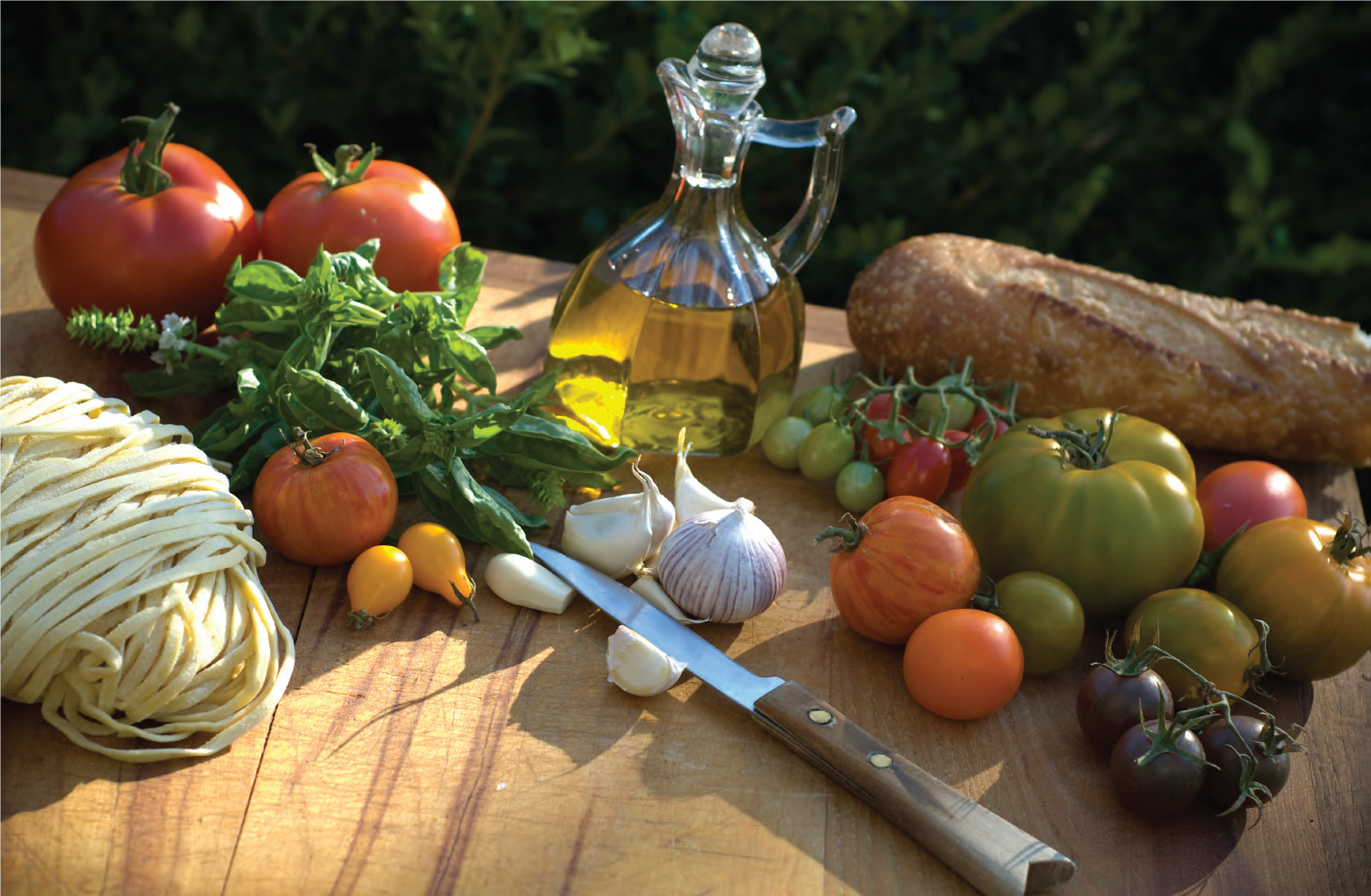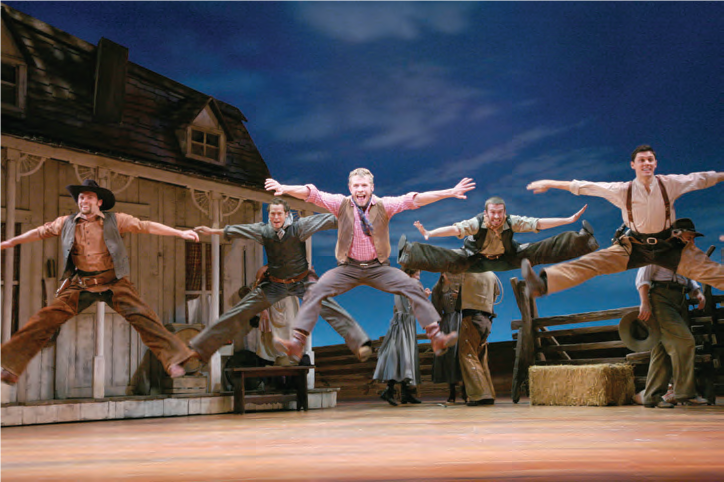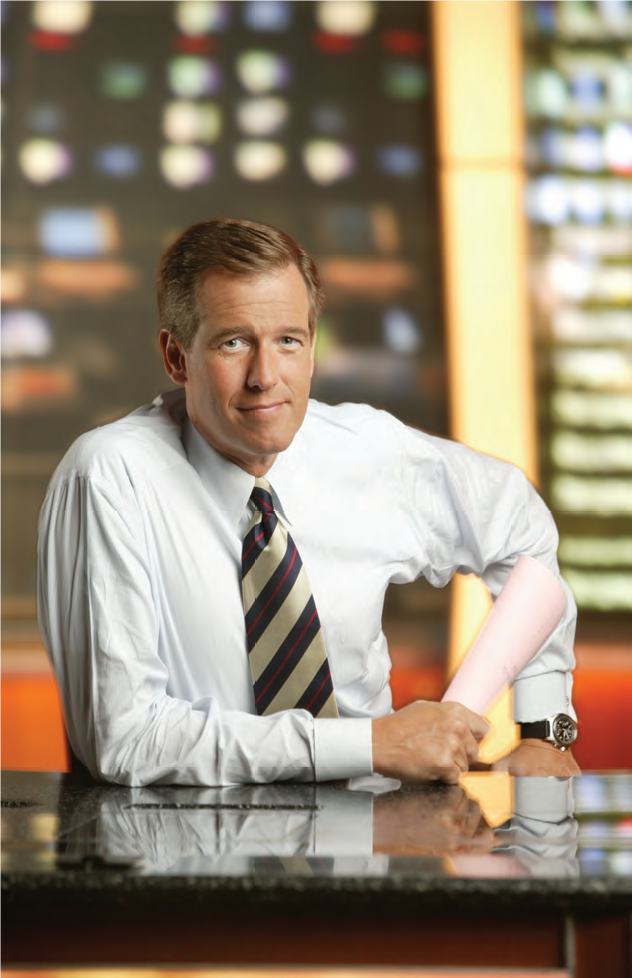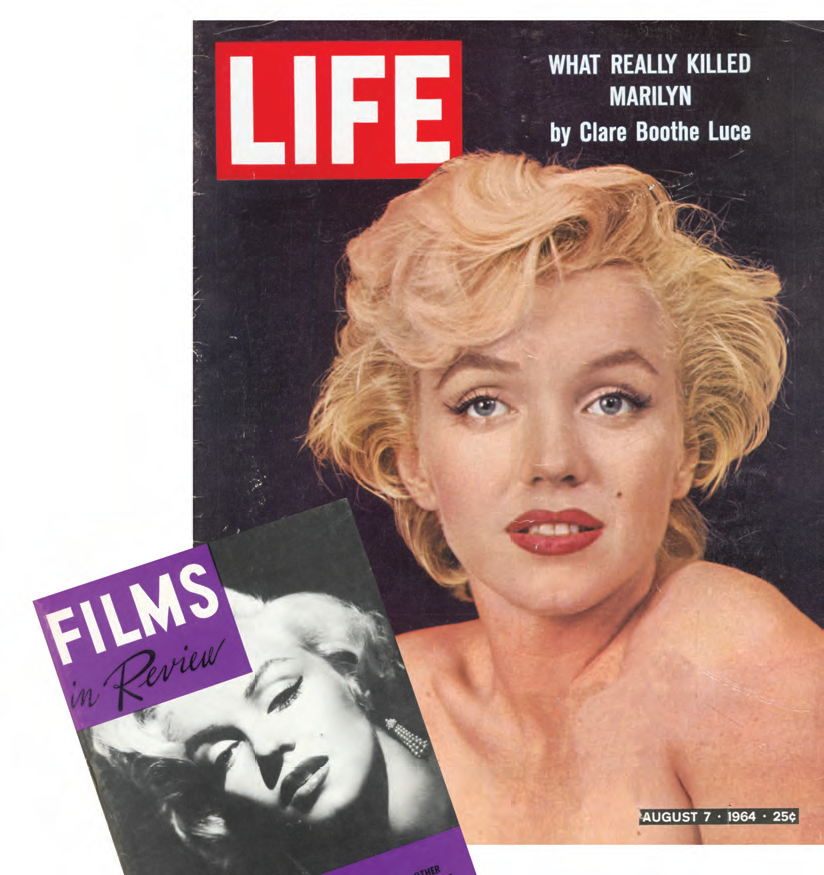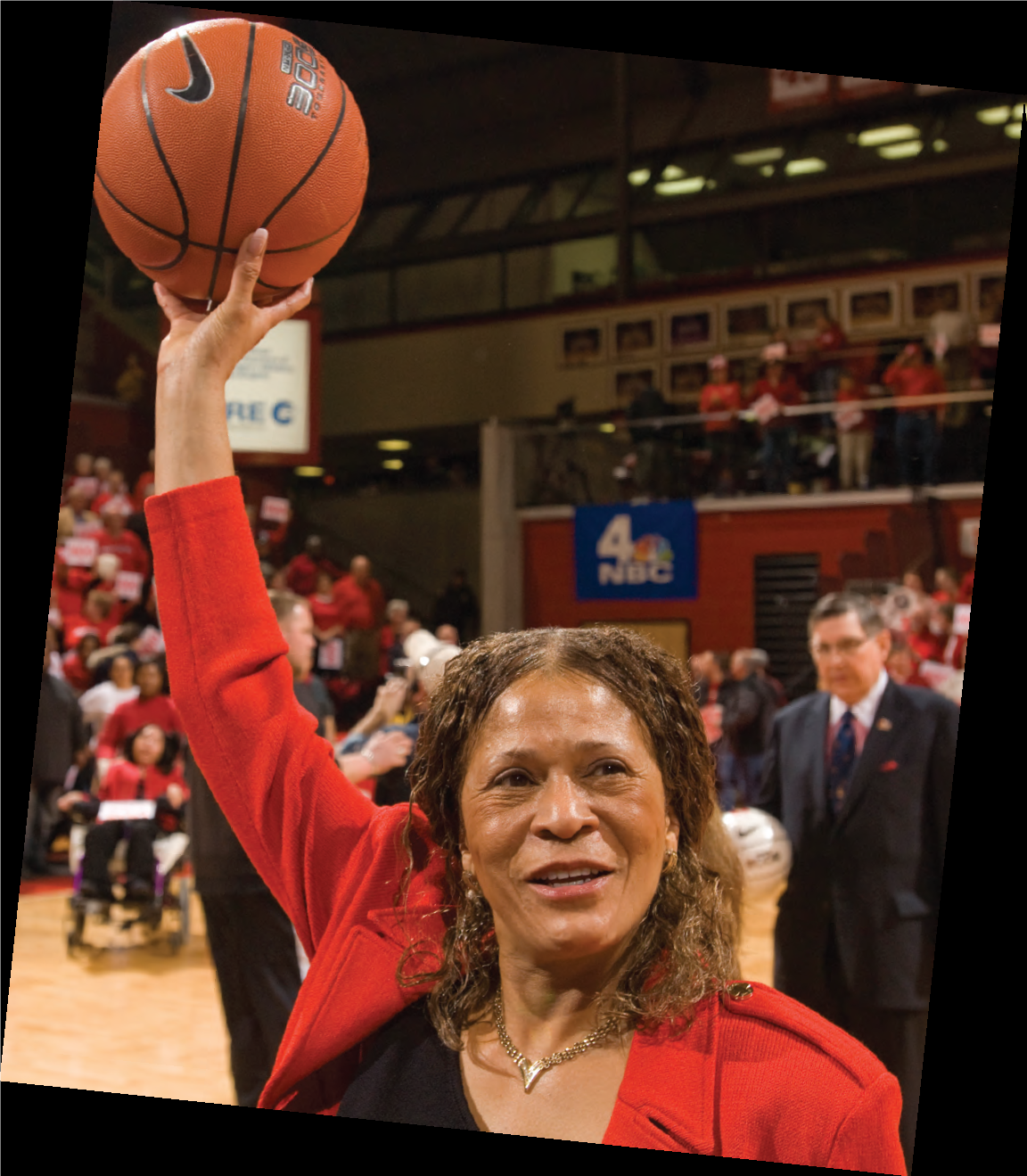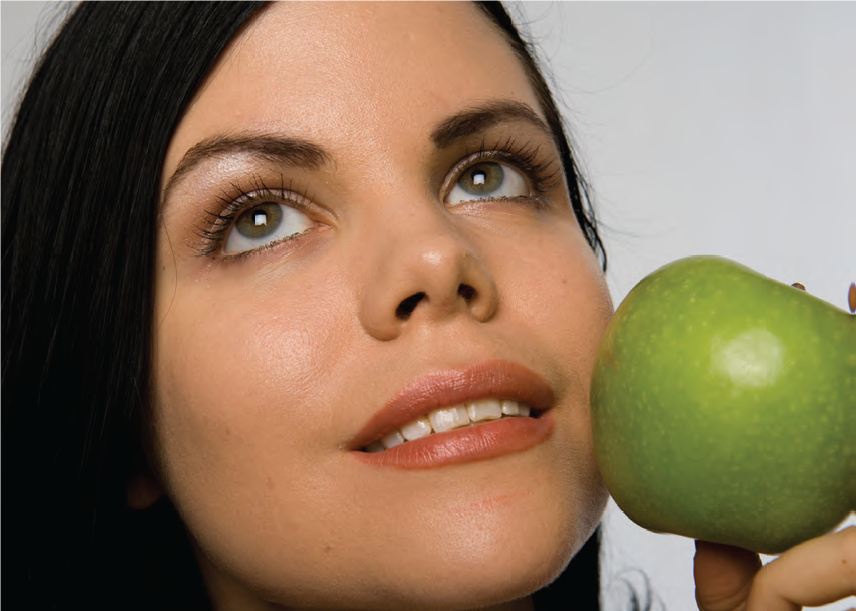- 413 Allen Ave. Allenhurst NJ 07711
- (732)531-4466
- visit website
- 225 Williamson St. Elizabeth NJ 07711
- (908)994-5138
- visit website
- 71 Midland Blvd. Maplewood NJ 07040
- (862)216-0589
- visit website
- 1906 Westfield Ave., St.B Scotch Plains NJ 07076
- (908)680-6185
- visit website
David Drake is in the house, and this— in the age of name-brand chefs playing musical stoves at multiple locales—is enough to raise the excitement level at the restaurant that bears his name in downtown Rahway.
Where David Drake goes, those with curious and refined palates follow. Thus, Restaurant David Drake has become a must on dine cards statewide. The chef who has done star turns at Stage House Inn, Ryland Inn and the Frog and the Peach here in New Jersey, as well as at the River  Café in Brooklyn Heights, turned an old insurance agency into a restaurant in 2005. The city that too often had been associated with a prison took on new luster and a new (and desirable) distinction: dining destination. Then, in 2007, he
Café in Brooklyn Heights, turned an old insurance agency into a restaurant in 2005. The city that too often had been associated with a prison took on new luster and a new (and desirable) distinction: dining destination. Then, in 2007, he  opened Daryl Wine Bar & Restaurant in New Brunswick. This year, he’d also been spotted on KP duty up at Alice’s Restaurant at Lake Hopatcong. When a chef spreads his wings in ways other than through the menu at his eponymous restaurant, there can be cause to worry. No worries in Rahway. Restaurant David Drake’s chef de cuisine Peter Turso is technically skilled and culinarily gifted. But on this night, with Drake in the kitchen and then doing a post-dinner rush survey of dining rooms both upstairs and down in this posh, yet winsomely rustic setting, there’s a confidence that speaks of decades of experience in high-toned, high-pressure kitchens.
opened Daryl Wine Bar & Restaurant in New Brunswick. This year, he’d also been spotted on KP duty up at Alice’s Restaurant at Lake Hopatcong. When a chef spreads his wings in ways other than through the menu at his eponymous restaurant, there can be cause to worry. No worries in Rahway. Restaurant David Drake’s chef de cuisine Peter Turso is technically skilled and culinarily gifted. But on this night, with Drake in the kitchen and then doing a post-dinner rush survey of dining rooms both upstairs and down in this posh, yet winsomely rustic setting, there’s a confidence that speaks of decades of experience in high-toned, high-pressure kitchens.
There’s no food misstep to speak of. The menus, both a la carte and degustation, are well-edited, largely seasonal and clearly focused on primary ingredients. It’s new American in a classical way— not silly-fussy, not kinetic with chemical experiments, not forcing taste issues by partnering two discordant flavors and calling it a “challenge” to the diner. That isn’t to say this is snooze food. Maine crab, flaky, sweet and tingling with freshness, is indeed challenged by a pickled cucumber chop underscored by an acidity that punches up the natural salinity of the crab. A swirl of heirloom tomato concasse brings out its sweetness and a cumin-scented tuile manages to unite every flavor on the plate. For a palate-cleanser, Drake puts a few favas on the plate, a meaty interlude between crab bites. There’s nothing revolutionary about the pepper-crusted seared yellowfin here, but its execution is flawless, including as counterpoints a rakish citrus salad and a feisty ginger vinaigrette you might not mind sprinkling on your next round of New Age sushi.
The textbook foie gras terrine can’t be ignored. Coupled with a mini ramekin of chunky fig preserves and a swirl of reduced cranberries, it’s a starter fit for Fall. When it’s a bitter-cold winter night, I’ll crave a big bowl of Drake’s carrot-ginger soup dusted with warming curry, sparked by lemon oil and made luxuriously rich by a pouf of whipped cream. That’s living right. Parmesan flecked gnocchi are treated right by being set in a wash of heirloom tomato water dotted with specks of the fruit along with scallions grilled and smoky and ready to be fork-skewered with those light, fluffy torpedoes of pasta. Drake always has had a masterful way with fish.
He handles a sea scallop with finesse by serving it astride carrots two ways: super-sweet in a soulful age, letting the broth enrich the scallop, and humble-hearty in a fricassee that adds texture to the dish. Halibut, pert amid a chop of alium-licked vegetables, laps up a basil pistou. But it’s the shrimp risotto that brings out my inner hoarder. The backdrop of lemongrass kicks the dish into high gear immediately, while snips of zucchini keep it grounded. Once you fork the whole assemblage into your mouth, it’s a wisp of Thai basil,  mysteriously minty and clovey, that makes the dish irresistible. Seconds? Gladly. Another irresistible accent partnership—the fool-proof combo of chanterelles and apricot puree—elevates slices of roasted duck breast, creamy white polenta and knobby baby turnips.
mysteriously minty and clovey, that makes the dish irresistible. Seconds? Gladly. Another irresistible accent partnership—the fool-proof combo of chanterelles and apricot puree—elevates slices of roasted duck breast, creamy white polenta and knobby baby turnips.
Chanterelles and apricots love each other and, in the end, they provide the flavor muscle for the dish. I’m just as fond of the roasted pork, which, on this night, was given the season-throwback sideshows of corn both in a purée and strained chowder, plus grilled asparagus. Here there is nothing on the menu for which you won’t find the right wine on the eclectic wine list. While there’s a wide price range, the middle-level bottles between $60 and $90 are where vinophiles will find relative bargains and the best connections to the food. We nabbed a midrange Charles Schleret Herrenweg Riesling from Alsace whose versatility with Drake’s food would be tough to match at any price.
I’m not sure I’ve met the match for the berry trifle here, largely because the almond shortcake that anchors the layering hits the trifecta of texture, balance of flavors and moistness. Tack on a rush of tart and sweet blackberries, a dollop of vanilla-scented cream and a scoop of strawberry sorbet, and you’ve got a truly grand finale. The chocolate tart—with its lemony pastry, brush of salted caramel, vanilla crème fraiche and sprinkling of pulverized pistachios—certainly can’t be considered an also-ran. Choosing cheese as dessert might find you presented with a plate of creamy Pierre Robert, a tangy goat’s milk number called Coupole, a nutty Pecorino, a butterscotchy aged Gouda and a spicy Cabrales, which is a dandy and snappy blue. It’s a fine choice for ending an evening here. So is making a reservation for next time on your way out. Restaurant David Drake is what a chef-driven restaurant is all about.

Editors Note: Andy Clurfeld is a former editor of Zagat New Jersey. The longtime food critic for the Asbury Park Press also has been published in Gourmet, Saveur and Town & Country, and on epicurious.com.
A Jersey Girl harnesses the power of the Net to make her own breaks in the music world.

Photos: Deborah Lopez
There was a time in the not-too-distant past when the fate of a singer/guitarist/songwriter like Allie Moss would be in the hands of managers, producers, agents and lawyers. Indeed, the Folklore of Creativity abounds in cautionary tales of the tragedies inherent in the battle between art and commerce. Catching the public’s collective ear has always presented emerging artists with problems. For decades, they have been hostage to the stranglehold that commercial interests had on production, publicity and broadcasting.
Paying for studio time, getting good placement for your CDs in stores, and arranging for airplay frequently involved some sacrifices—like signing over percentages of one’s earnings. For life. The 20-something musicians of today, while hardly immune to bad endings like these, have taken progressively stronger control of their destinies. Moss, whose approach to self-promotion is as smart as her music, provides a refreshing view of the new, largely Internet-based methods of production and public relations.
The results speak for themselves. Just since the leaves began turning this autumn, she has had her song “Corners” featured on the ABC series Brothers & Sisters, followed by a career-boosting studio segment on Good Morning America. Moss’s fans keep up with her on Facebook, MySpace, YouTube, iLike and Tumblr. Her new album, Passerby, can be downloaded through iTunes or Amazon. Moss’s performance dates (she tours with Ingrid Michaelson) are listed at alliemoss.com. And those who hang on her every lyric can also hang on her every word at, you guessed it, Twitter.
Welcome to the world we live in—a bewildering matrix of blogs, search engines, social networking sites, cell phones, WiFi… but the basic situation is that you can access Ms. Moss’s oeuvre 24/7/365. Go check out her act at a club or in concert, and when you get home you can find dozens of her MP3 files; some are free, some are for-pay downloads. But the bottom line is that none of this is under the control— financial or artistic—of the record labels. Moss lives—or, more accurately, since she tours constantly, alights from time to time—in Jersey City. She laughs about her somewhat frantic life and admits that touring seemed an impossible goal when she was a child, since she suffered from paralyzing stage fright. “I got so scared once that I completely forgot the lyrics to the song I was singing. I just stood there, horrified and embarrassed.” As a teenager, Moss began journeying into New York to listen to friends work in clubs.
This led to her singing and playing backup, and then to finding gigs of her own. Several years ago she met Michaelson, a fast-rising singer and songwriter from Staten Island, and began backing her. Eventually she started to tour with Michaelson. Soon came their appearance on Good Morning America and then a gig as an opening act for the Dave Matthews Band. As Moss rattles off the names of her favorite contemporary musicians—among them Josh Ritter, Death Cab for Cutie, David Bazan and Greg Laslow—she habitually refers to their web sites, their pages, their video clips and the mashups they’re in. If you’re a young musician, it’s an open-source world. As Moss says, “Radio is cool, and once you’re established it’s critical. But it’s hard to break your music on radio if you’re not already a name. It’s so easy to find the music you want to hear online.” voice and deft guitar work.
Her writing explores the complex, sometimes joyous, sometimes heartbreaking passage from teenager to woman. Moss dodges the Pollyanna mentality that can make some folk music unpalatable. Her urban background doesn’t provide room for many illusions, but she knows, and expresses, the difference between being skeptical and falling into cynicism. Moss talks writing while on tour, snatching bits of time to jot down lines in an always-present notebook. On the song “Paper Cup,” she balances hope and caution, encouragement and doubt, and her delicate tones perfectly balance her spare, elegant playing. Many older, more experienced writers would love to have her rhetorical command. Of course, there’s the side of Moss that likes to sing “Rubber Ducky,” too. A spare, elegant “Rubber Ducky,” to be sure. In the future? “I love playing with Ingrid, and I guess I’ll do it as long as it works for both of us,” Moss says. “She’s so talented and so smart. I’ve learned tons from her, not only about writing and playing, but about the business side, about how to deal with touring.” So there’s that, and doing gigs in places like Kenny’s Castaways and the Baggott Inn in New York and Maxwell’s and The Saint in New Jersey, and writing songs. Moss also teaches voice.
She’s a devotee and practitioner, and, she thinks, the only Certified Level–1 instructor in the area of a method known as Speech Level Singing. And then, after all that’s taken care of, she allows, half sarcastically and half-wistfully, that she’d like to find time for some “normal” stuff. Alas, as Allie Moss’s star continues to rise, she may find that normal is a relative term…and that time could soon be the most precious commodity of all.
Editor’s Note: Bill Mehlman is a freelance writer with a passion for the music business. He lives and works in New York City.
Backstage at Paper Mill Playhouse
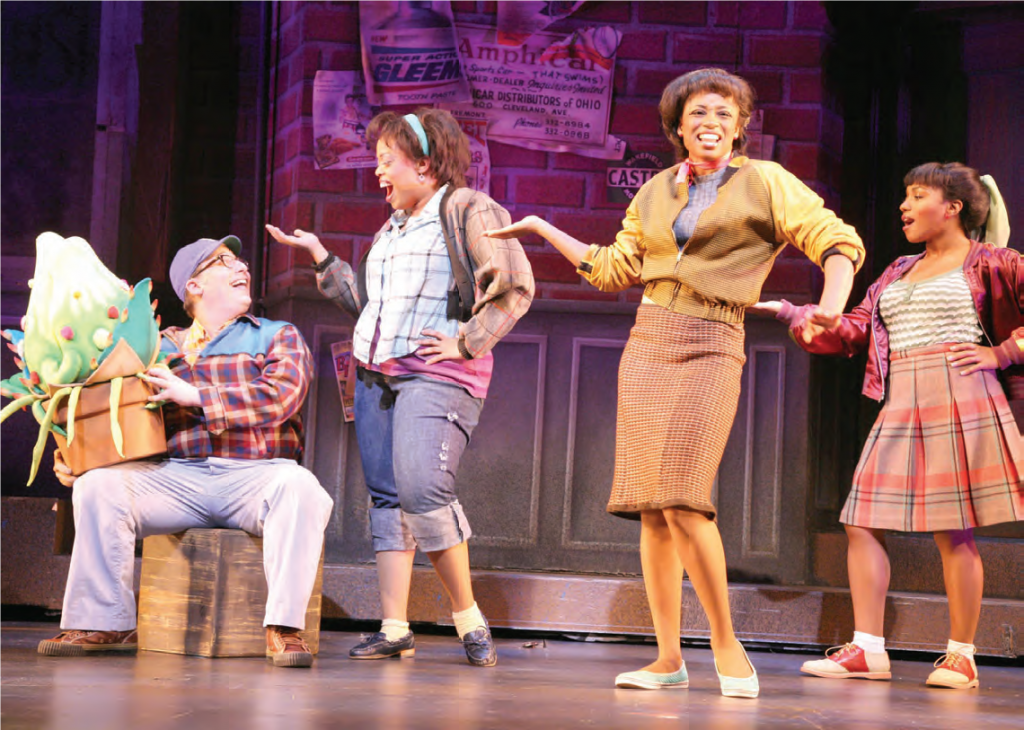
Oh, were it only that simple. Big names may help Paper Mill Playhouse stay afloat, but it’s cultivating the little ones that guarantees a bright future
 Financial Crisis May Force Paper Mill Playhouse To Go Dark. That was a headline from April 2007—not 2008 or 2009. Perhaps the timing was a blessing. Had New Jersey’s state theater run aground amidst of the current financial crisis, it might have gone the way of Lehman Brothers. Instead, a few weeks later, thanks to $300,000 in donations, audiences were treated to a rousing production of Seven Brides for Seven Brothers. Next, the Township of Millburn stepped in and purchased its Brookside Drive land and buildings for $9 million, then leased them back to Paper Mill for 75 years as a hands-off landlord. Present crisis averted, the folks that run PMP began thinking about the future. The buzz words they use are Inter-generational Programming. “Productions specifically designed to broaden our audience appeal to a younger group,” explains Shayne Miller, Director of Press and Public Relations. “By providing ‘family favorite programming’ in our mix—for example High School Musical and Peter Pan—we may attract first-timers to the theater as parents taking their children.
Financial Crisis May Force Paper Mill Playhouse To Go Dark. That was a headline from April 2007—not 2008 or 2009. Perhaps the timing was a blessing. Had New Jersey’s state theater run aground amidst of the current financial crisis, it might have gone the way of Lehman Brothers. Instead, a few weeks later, thanks to $300,000 in donations, audiences were treated to a rousing production of Seven Brides for Seven Brothers. Next, the Township of Millburn stepped in and purchased its Brookside Drive land and buildings for $9 million, then leased them back to Paper Mill for 75 years as a hands-off landlord. Present crisis averted, the folks that run PMP began thinking about the future. The buzz words they use are Inter-generational Programming. “Productions specifically designed to broaden our audience appeal to a younger group,” explains Shayne Miller, Director of Press and Public Relations. “By providing ‘family favorite programming’ in our mix—for example High School Musical and Peter Pan—we may attract first-timers to the theater as parents taking their children.
These parents are likely to be in the important age group of 35 to 55. Once at the theater, we have the opportunity to convert these parents to return, as a couple, to additional shows in our season that may be more adult-focused. We can then target them via direct-response efforts.” Those efforts include trumpeting the big names that have graced the PMP stage since it began operating some 75 years ago. Lynn Redgrave (top left), Ann Hathaway, Patrick Swayze, Bernadette Peters, Liza Minnelli, Chita Rivera, Carol Channing, Betty Buckley, Ann Miller, Estelle Parsons, Edward Villella and Nick Jonas (yes, that Nick Jonas) are among the luminaries whose credits include Paper Mill appearances. This past fall, Paper Mill 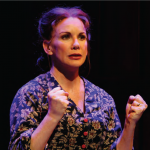 Playhouse presented Laura Ingalls Wilder’s Little House on the Prairie as a musical. It starred Melissa Gilbert (middle left), who played Laura in the famed television series from the age of 9 to the age of 20. In this production, the 45-year-old Gilbert—who recently served two terms as president of the Screen Actors Guild—was cast as Ma.
Playhouse presented Laura Ingalls Wilder’s Little House on the Prairie as a musical. It starred Melissa Gilbert (middle left), who played Laura in the famed television series from the age of 9 to the age of 20. In this production, the 45-year-old Gilbert—who recently served two terms as president of the Screen Actors Guild—was cast as Ma.
Another noteworthy notch in PMP’s belt. “We will also look for shows with broad inter-generational appeal, like 1776 (bottom left),” adds Miller, “which was appealing to seniors, parents, school groups and children. Our Children’s Theater and Education programs can also serve as an entry point to the theater.” For Artistic Director Mark Hoebee and Executive Mark Jones (left), reaching out to young audiences is more than just a marketing strategy. He sees the theater’s playing an important part in the Garden State’s education picture. “We need to have the arts in our children’s live as they are being educated,” says Jones. “Our role, within that, and in the state of New Jersey, is to have a statewide Theater Education program.
It doesn’t just bus kids in to see one of our mainstage productions, but actually works in the schools proactively, runs a healthy theater school with five hundred people enrolled— which we have—and runs one of the best summer conservatories in America. The Paper Mill’s ‘Rising Star Award’ program, which encompasses all twenty-one counties in the state, is very popular.” Whatever the future holds for Paper Mill, and the arts in general, some things will never change. “We’re unique,” says Jones, “because we have original productions of musical theater classics, as well as new works. Here at Paper Mill, we put our stamp on everything we create.”
All photos courtesy of Paper Mill Playhouse: Little Shop of Horrors, Lynn Redgrave/The Importance of Being Earnest, Kiss Me, Kate and Oklahoma!: Gerry Goodstein; Melissa Gilbert/Little House on the Prairie, The Musical: Jerry Dalia; 1776: Kevin Sprague.
Don’t say anything about New Jersey around BRIAN WILLIAMS unless you have something good to say. The Garden State was a springboard into a news career that has seen him defy the odds and reach the pinnacle of his profession. When Williams has to dig deep for strength or  inspiration, New Jersey serves as his touchstone. The instant he motors past that center stripe in the Lincoln Tunnel, he feels he is home again. In his chat with the NBC Nightly News anchor, EDGE editor MARK STEWART discovers that what you see (and hear) is what you get. Whether getting a story right, hosting Saturday Night Live, or putting his money where his heart is, Williams is as authentic as they come.
inspiration, New Jersey serves as his touchstone. The instant he motors past that center stripe in the Lincoln Tunnel, he feels he is home again. In his chat with the NBC Nightly News anchor, EDGE editor MARK STEWART discovers that what you see (and hear) is what you get. Whether getting a story right, hosting Saturday Night Live, or putting his money where his heart is, Williams is as authentic as they come.
EDGE: To reach the level you have in the business, an anchor must find the perfect balance between being a newsman and a performer. How did you find that balance?
BW: I’ve never had a lesson in performance. I’ve never had anybody tell me how. I have had great role models, from watching Cronkite every evening of my young life—I lived in a household where dinner would not be served until he said, ‘That’s the way it is’—to working beside Dan Rather at CBS and, more importantly, being taken under the wing of Tom Brokaw at NBC. He made sure I was in the right spot at every point. When it was time to be chief White House correspondent, he made it clear to me that it was time to be chief White House correspondent, and I moved down to Washington with my family. So at every point I’ve been so fortunate either to have watched a great example or worked next to one, and be mentored by one.
EDGE: Cronkite was your idol.
BW: He was my absolute, North Star idol. Walter Cronkite was the guy I always wanted to be, and he lived long enough for me to make that very clear to him. That was one of the great moments of my career.
EDGE: You started your climb in Middletown, New Jersey. How did you work your way to the top?
BW: I didn’t have any contacts. I had no way in through the front door or the back. So climbing in the window of the television news business and coming up through the basement is the only way I know how to get ahead. That meant moving out to Kansas, learning the business, and being willing to crawl through broken glass to get ahead. If you have your eyes on a prize in this country, there’s nothing that can stop you—I’m a living example of that. I am not college educated, I did not grow up with honed skills or a family that knew what a prep school was. I didn’t know what the Ivy League was when I was in high school. It just wasn’t in my ken. But if you’re a hustler—and I’ve never regarded that as a pejorative, that word’s a positive in my book—the world is your oyster.
EDGE: At what point did you become comfortable being Brian Williams?
BW: I’ve thought about it a lot. Various local stations in my twenties on my way up made vain attempts to put me with consultants. I had to sit through a focus group once and listen to what they said about me. That is not for the faint of heart, and something I don’t recommend to people. But after a while, as I came up through the industry, I thought Well, this must be working. I have no choice but to be who I am. I went with who ‘brung me to the dance.’ Even so, my daughter will tell you the Brian Williams on Nightly News is not the Dad she knows. She knows someone else entirely. She will tell you that the Brian Williams of Saturday Night Live or Jon Stewart or Conan is much closer to the guy she knows.
EDGE: How did the SNL hosting gig develop? Who pursued whom?
BW: I was pursued. Lorne Michaels had made noises about it for years, actually. Lorne, sadly, has to sit through a lot of dinners and charity events that I emcee, and I tend to mix it up during those because they can be as dry as dirt. Finally he came to me and said, ‘This is a serious offer’ and gave me an airdate. I told him I had 26 years of a career to worry about and I knew I could easily dispose of it in 90 minutes. I asked everyone in my life—I asked not just Tom Brokaw, but also his wife Meredith. Jane and I talked about it for hours. I wanted to be sure that I wasn’t flushing what credibility I had down the toilet.
EDGE: I recall saying to my wife when you were announced that this was the bravest hosting decision in the history of the show.
BW: When I wrote the monologue, the first thing I said was, ‘I know what you’re thinking…is this really a good idea?’ That was actually my favorite moment in the show, because it was the elephant in the studio.
EDGE: So what made you say Yes?
BW: I had never met Chevy Chase and I saw him outside SNL in the hallway talking to a friend of mine. I went up to him, introduced myself, and asked him what he thought I should do. I explained that I owed Lorne a decision tomorrow. He said, ‘I watched Dan Rather for years and I never got any closer to knowing who he is. I think if you do this, I might get to know who you are.’ And that was the clinching vote. I called Lorne and accepted. I had to reject about fifty percent of the sketch ideas the writers proposed. Their job, of course, is to make a total horse’s ass out of the host.
EDGE: The skit I remember is the one where you played a firefighter. It was a totally authentic performance. Where did that come from?
BW: Sharp-eyed viewers will notice that the helmet on my lap said OVFC #11 and Williams. That stands for Old Village Fire Company, Engine 11, in Middletown Township. That was my gear. As a firefighter years ago, on a volunteer basis in Jersey—who still hangs around New York City firefighters— that was the easiest ‘character’ I could have done. I knew the lingo already, so it was easy.
EDGE: There’s still a lot of Jersey in you, isn’t there?
 BW: When I pass into New Jersey there’s something that happens to me at mid-span on the GW Bridge and midway through the Lincoln Tunnel. I call it my ‘power corridor’. I feel most at home there. I speak New Jersey. New Jerseyans are real. It’s the most densely populated state in the union and yet I can tell from your accent if you’re from South Jersey or North Jersey. I can usually tell if you’re from the Mid Shore. We have a lot of different regions, and yet I think there’s a baked-in pride. We have to put up with a lot of crap. I don’t take kindly to a lot of Jersey jokes because I know a lot about my state. Way too many people judge our state based on one stretch of highway on the Turnpike along refinery row. And that’s unfortunate. I think if we had it to do over again, we wouldn’t route so many millions of motorists right past the most heavily industrialized region of the East Coast.
BW: When I pass into New Jersey there’s something that happens to me at mid-span on the GW Bridge and midway through the Lincoln Tunnel. I call it my ‘power corridor’. I feel most at home there. I speak New Jersey. New Jerseyans are real. It’s the most densely populated state in the union and yet I can tell from your accent if you’re from South Jersey or North Jersey. I can usually tell if you’re from the Mid Shore. We have a lot of different regions, and yet I think there’s a baked-in pride. We have to put up with a lot of crap. I don’t take kindly to a lot of Jersey jokes because I know a lot about my state. Way too many people judge our state based on one stretch of highway on the Turnpike along refinery row. And that’s unfortunate. I think if we had it to do over again, we wouldn’t route so many millions of motorists right past the most heavily industrialized region of the East Coast.
EDGE: So what is it that defines New Jerseyans?
BW: There’s a moxie, there’s a street smartness, there’s a reality to being from New Jersey. New Jerseyans have texture. They have grit. We aren’t always the most earnest members of the jury pool, but we’ll be the jury foreman, and we’ll get you a verdict.
EDGE: What role does grit play in your job?
BW: Grit is what it’s all about! Grit is life experience. It’s having a few layers of paint worn off of you, so you’re not shiny and new. This is not your first rodeo. A little skepticism. Even some cynicism. Grit has served me well in life. I just think grit equals authenticity today. And to make it today, you’ve got to have it.
EDGE: What do you remember when you look back on your New Jersey days?
BW: I had the perfect upbringing; I wouldn’t do it any other way. I get very emotional and gauzy, warm and fuzzy, and romantic about my upbringing—even though at the time it felt ordinary and at times a struggle. There were kids at Mater Dei High School who had a lot more than me, and it wasn’t my proudest moment to look at the back page of the yearbook and see the colleges other kids were headed to. And while I screwed up my education and came within inches of becoming a colossal failure—I interviewed for a police dispatch position out of Freehold thinking that would be a good, steady job—life went in a different direction. But when I go back there now I would like to think I have a flag in that soil that is mine.
EDGE: One of those flags will be in Newark soon, where the Horizons Summer Enrichment Program is opening a new location. You and Jane must get pulled in so many directions, and yet you’ve devoted yourselves to Horizons completely. What is it that you have found so appealing about it?
BW: You know how they say We know you have a choice in airlines and we appreciate you flying with us? My wife and I have been blessed in many ways in life, mostly financially—we never thought we’d have any money—and we have chosen to give most of our charitable dollars to a single cause, because Horizons changes lives in front of your eyes. The children chosen for the program end up in a different life. They are transported, as if by a giant hand, and lifted up. It’s just the most extraordinary program, and it only exists because of the good people who run it. Mr. and Mrs. Williams will only be happy when there is a Horizons-affiliated school in every city, town and hamlet that feels they need one. If people would just go to the web site [horizonsnational.org] and watch the piece we did, it would be the leading school enrichment program in the country. I’ve just never seen a return on the volunteer hour or donated dollar quite as dramatic as Horizons.
EDGE: EDGE readers live and work relatively close to the new location. Tell them why they should volunteer or donate to Horizons?
BW: It’s that feeling you get when you give a gift that’s so great that it gets your endorphins going just to give it away. The feeling you’ve knocked one out of the park. Multiply that by a hundred. Or a hundred thousand. That’s how giving to Horizons will make you feel. Most Americans, in the course of their lives, are lucky if they get to change one or two lives. This is a very easy way to do that on a larger scale, with a tangible, human, smiling result.

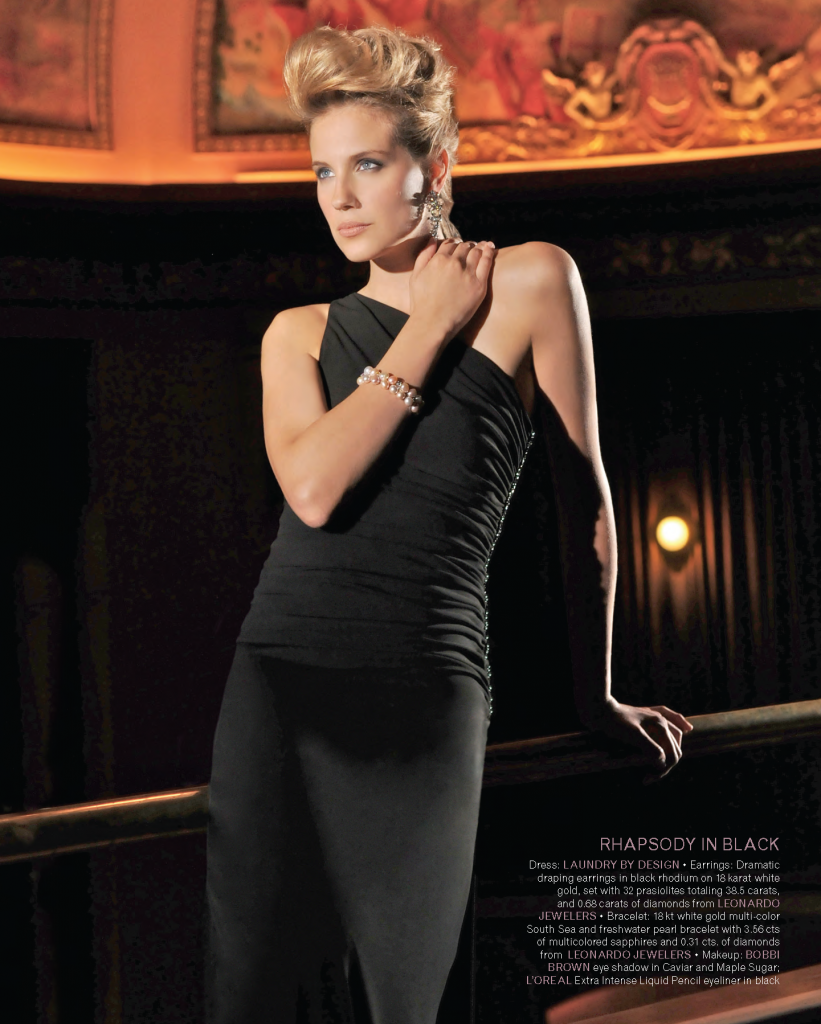
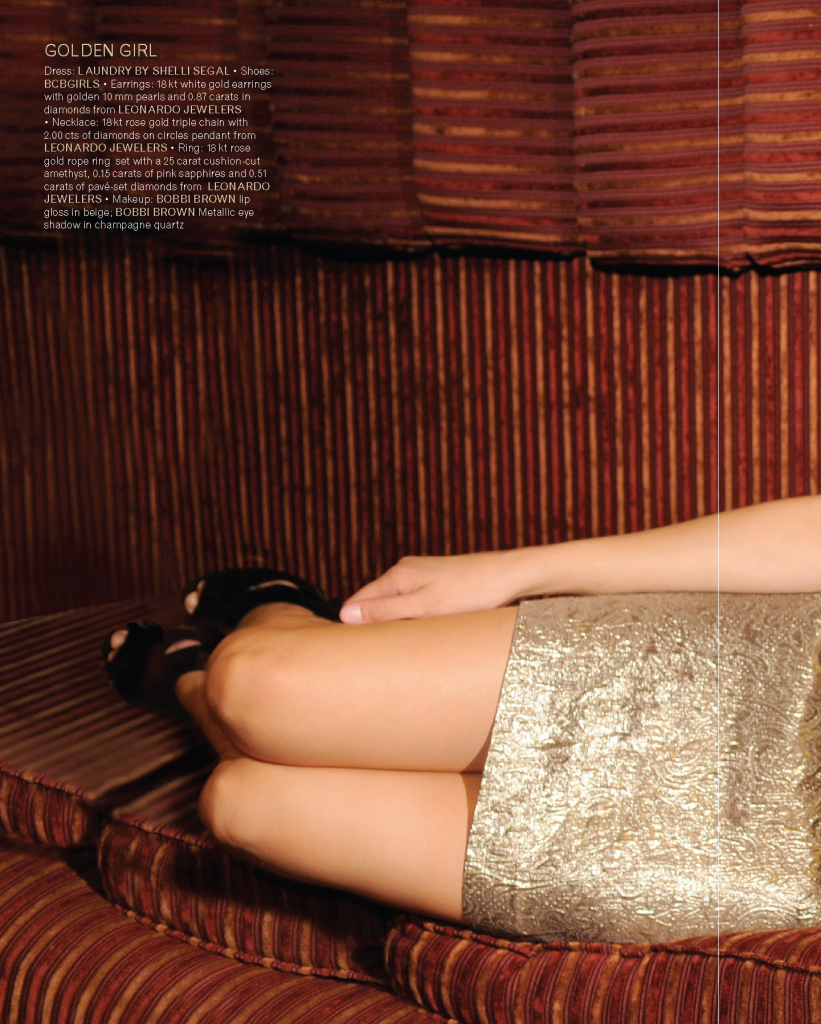



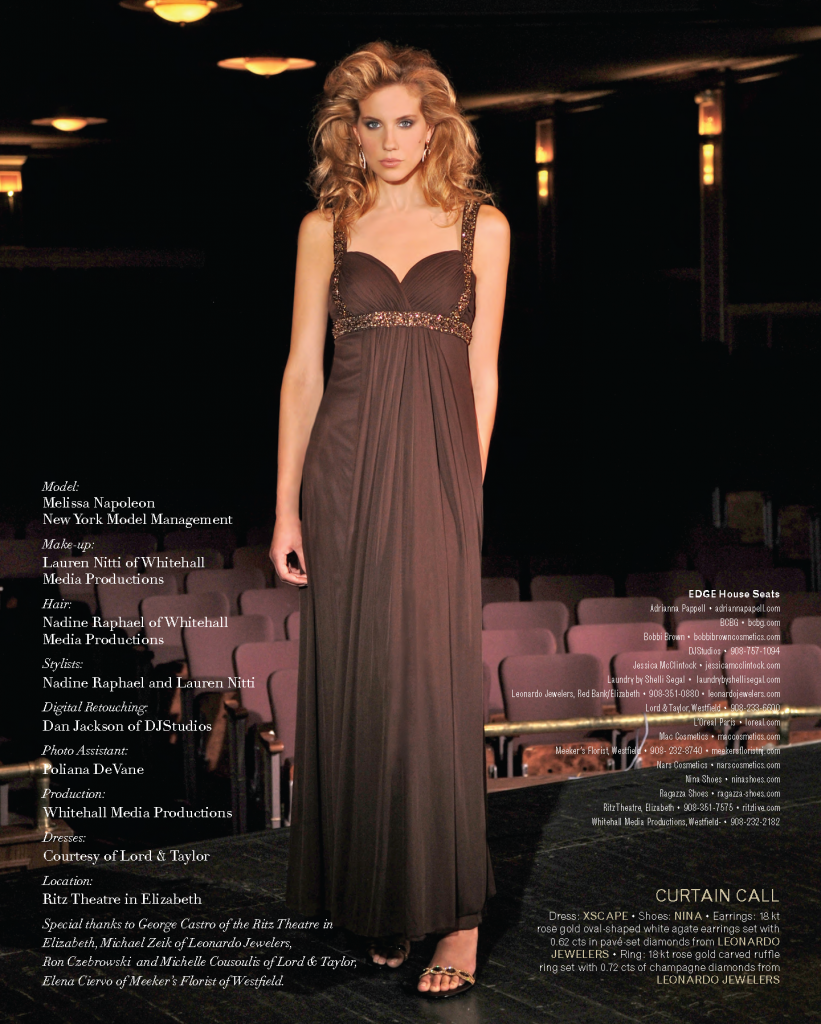
Planning to step up your game after the holidays? Worried that you’re not up to the challenge? Listen to your body (and your doctor) and you’ll avoid the sprains, trains and stress that send others to the bench.
Three cheers for medical science. Although staying fit still takes hard work and commitment, remaining injury-free is easier than ever. Whether you’re a weekend warrior training for your first triathlon or you live on the tennis courts, you have two missions when you’re pushing the performance envelope: Do your best… and make it home in one piece. The key to success (or survival, depending on your sport) is recognizing that there are three important components where your body is concerned: BEFORE, DURING, and AFTER. Understanding the basics of each not only gets you on the court or field or road—it’s what ultimately will keep you there.
BEFORE
The right preparation can save you a world of hurt, but often people skip this step. Here’s how to ensure you’re ready to take on all comers:
- Check yourself out. Most people know it’s wise to consult your doctor before starting a new exercise routine, but there’s another professional who might be just as key. “I’m a strong advocate of having a person trained in physical therapy take a look at the muscular-skeletal system,” says Jim Dunleavy, PT, MS, Administrative Director of Rehabilitation Services for Trinitas Regional Medical Center. “We all come with little quirks that we may not know we have. For instance, if someone has resisted motion in their hip, that could cause a knee or ankle problem. After the assessment, they can make sure that their exercise program attends to those potential issues.”
- Ditch the heels. Women who wear heels put themselves at risk for injuries in sports. “If you wear heels during the day, your calf is shortened all day long, and you won’t have the flexibility and the strength to participate in your activity without hurting,” Dunleavy says. You’ll need to engage in some extensive stretching of your lower legs before and during your activity to help minimize the chances of injury.
- Be sure you’re balanced. You may be working hard to get your muscles in shape for your particular sport, but you can’t ignore the rest of your muscular system. “You need to pay a little attention to your core muscles, to A Special Health & Wellness Section from Trinitas Regional Medical Center balance things,” says Dr. Richard Mackessy, Chairman of the Orthopedics Department at Trinitas. “If you overdevelop one area, like your chest, but haven’t done anything to the back, you’ve created an imbalance in your shoulders that makes it so they’re pulled forward constantly, and creates a risk of pain.”

DURING
While you may be concentrating on squaring up to the ball or keeping your marathon pace, there are other things to keep in mind before you shift into high gear:
- Warm up. There’s been so much debate on how to get rolling—just stretching, stretching and warm-up, or full speed ahead—but most experts agree that a warmup is essential. “You don’t want to just walk onto the field and play the toughest match without doing anything,” Dr. Mackessy says. “We recommend going through a period of warming up, where you’re going at half the pace. If you’re playing tennis, you might hit balls at a very relaxed pace for a few minutes, then stop and do some stretches before you really start playing.”
- Don’t go crazy. Weekend warriors may be all gung-ho about doing the activities they love when they have the time, but it’s best to work up to an all-day round-robin. “If you’re working 9 to 5, your body is not built up to withstand the constant stress that’s placed on the body with a prolonged sports activity,” Dunleavy says. “Your body can only take so much—overuse can result in inflammation, making it very difficult to use that area without pain.”
- Stop if you have pain. Forget that old No pain, no gain adage—if you’re hurting, take a break. “If you have pain, you need to stop playing,” Dr. Mackessy insists. “You don’t need to hurt yourself and be laid up for six weeks.”

AFTER
When you’re ready to pack it in for the day, there are a few tricks you can use to help ensure you’ll be ready to achieve peak performance the next time out:
- Stretch it out. After a brief cool-down (like the warmup, you’re going at a more relaxed pace), be sure to give your muscles a well-deserved stretch to keep them limber. “Hit all the common stretches—legs, arms, shoulders,” Dr. Mackessy suggests.
- Nurse your wounds. If you do have pain and inflammation—the most common results of overuse injuries—there are a number of steps you can take to decrease the swelling, either at home or under a doctor’s care. “Swelling is going to retard the healing process, so you need to cool down the tendon with ice,” Dunleavy suggests. “We can also try to stimulate the healing process by increasing blood supply with electricity, heat and ultrasound, or by injecting medications, like cortisone or steroids. We can even load medication into an electrode and use electricity to drive medication into an area.”
- Assess your performance. Play Monday morning quarterback and see what you can improve at your next sporting event. “John MacEnroe once said that he learns more from losing than from winning,” says Dr. Rodger Goddard, Chief Psychologist and Director of Wellness Management Services for Trinitas Regional Medical Center. “Being able to look back at what was disappointing in our performance and devise a plan to improve our technique, execution and strategy in these areas is an important skill.”
Editor’s Note: Lisa Milbrand is a New Jersey-based writer whose articles on health and relationships appear in Parents, Arthritis Today and Modern Bride. Her blog themamahood.com celebrates the life of a working mother.
The Lola in Lola Latin Bistro, isn’t a person, but an attitude. “The name Lola sounds fun and exotic and Latin,” says Grace Castagnetto, the 25-year-old chef who inspired this fiesta of a restaurant in Metuchen, which is exactly that—fun, exotic and very Latin.
It’s a party, Lola Latin Bistro, a lunchtime/dinnertime celebration of Castagnetto’s spirited takes on the foods she grew up with in a Peruvian household in Perth Amboy coupled with what she learned as a culinary student in New York and as a  mainstay in
mainstay in 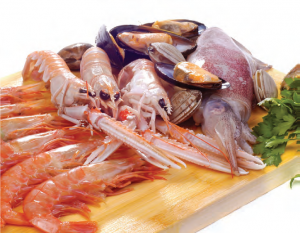 the kitchen of the venerable Frog & the Peach restaurant in New Brunswick. That’s where restaurateur Nick Borzone met her and decided to create a restaurant that would showcase her talents. Thus was born Lola, a hot-pot of Latin flavors accented with the young chef’s awareness of global trends and ingredients. Does it work? One look around the high-energy parlor of a dining room on an SRO weekend night tells you food and diners are clicking, big time. There are bountiful bowls of Brazilian fish stew, fat pork chops plated with a colorful pineapple-jalapeno salsa and cocktail glasses of ceviches going out to tables and, momentarily, stopping conversation. If folks in the area who knew this spot on Durham Avenue as the longtime home to a traditional Italian restaurant had their doubts when Lola opened a year ago, they don’t today. Lola is a firing-on-all-cylinders smash. That’s probably because Castagnetto has the gumption to turn garlic shrimp on its ear, taking a same-old, same-old starter and bumping up its flavor quotient with an infusion of warming, smoky-sweet guajillo chilies. She brushes baby pork ribs with mango and a mix of hot-woodsy spices, cooks them till they’re spoon-tender and elicits swoons from diners. This chef knows how to seduce. She pays homage to her South American heritage with empanadas that are basic and beautiful, such as the pockets of pastry filled with goat cheese and olives, or luxurious and alluring, such as the little bites stuffed with shreds of filet mignon.
the kitchen of the venerable Frog & the Peach restaurant in New Brunswick. That’s where restaurateur Nick Borzone met her and decided to create a restaurant that would showcase her talents. Thus was born Lola, a hot-pot of Latin flavors accented with the young chef’s awareness of global trends and ingredients. Does it work? One look around the high-energy parlor of a dining room on an SRO weekend night tells you food and diners are clicking, big time. There are bountiful bowls of Brazilian fish stew, fat pork chops plated with a colorful pineapple-jalapeno salsa and cocktail glasses of ceviches going out to tables and, momentarily, stopping conversation. If folks in the area who knew this spot on Durham Avenue as the longtime home to a traditional Italian restaurant had their doubts when Lola opened a year ago, they don’t today. Lola is a firing-on-all-cylinders smash. That’s probably because Castagnetto has the gumption to turn garlic shrimp on its ear, taking a same-old, same-old starter and bumping up its flavor quotient with an infusion of warming, smoky-sweet guajillo chilies. She brushes baby pork ribs with mango and a mix of hot-woodsy spices, cooks them till they’re spoon-tender and elicits swoons from diners. This chef knows how to seduce. She pays homage to her South American heritage with empanadas that are basic and beautiful, such as the pockets of pastry filled with goat cheese and olives, or luxurious and alluring, such as the little bites stuffed with shreds of filet mignon.
If you need to choose, go with the basic, since the beef empanada falls shy on juiciness and seasoning. But there’s nothing shy about the meaty chorizo con queso, with its tandem of heat-licked Spanish sausage tempered by a wash of tangy cheese that you roll into a flour tortilla. Tuna tartare goes Latin here courtesy of tortilla-shaped crisps that provided a cheery textural counterpoint to the silky seafood. I didn’t think the starter needed the schmear of guacamole between fish and chip; if anything, it clouded the play between main elements. Think you know all about jalapeno? You can’t, not unless you’ve experienced Castagnetto’s garlic-and-ajipanca-marinated pork tenderloin. She gives the pork a night in the marinade that lets the ancho-esque taste of the Peruvian ajipanca chile shine and then plates it with a jalapeno puree tamed by slow cooking with scents of cumin and sea salt.
She coaxes an uncommon sweetness out of the normally hot jalapeno, allowing it to bring out the best in the pork. Factor in a heap of lime licked Spanish coleslaw on the side, and it’s an entrée sensation. That Brazilian seafood stew shows the care taken by the kitchen to make sure each shrimp, mussel, clam or piece of fin fish struts its stuff in the broth of onion-strewn tomatoes. Salmon isn’t shortchanged, but coupled with mango that glazes the rich fish and makes it taste like a whole new species. But the biggest and best surprise of the night was what the chef did with chicken: Pumped up by bright citrus flavors and a burst of cilantro, then set astride rice enriched by coconut milk and flecked with scallions, chicken gets a full-regalia makeover from wallflower to prom queen.
We leaned in to discuss dessert options, necessary because, by this point in the night, the party at Lola was in full swing and the noise level bordering on nightclub. The loquacious host came by to advise, a server who confided his sideline is sweets pitched in his two pennies and, of course, we’d spied finales being delivered to tables around us. The skinny? Don’t miss the tres-leches cake, probably the best version of the Latin three-milks cake I’ve had in the state —moist, not too sweet and creamy-textured as it was. And the flan, a wiggly, eggy, thoroughly custardy rendition of the classic. It’s hard to leave a good party. But at Lola Latin Bistro, I suspect the party’s only started.

Editors Note: Andy Clurfeld is a former editor of Zagat New Jersey. The longtime food critic for the Asbury Park Press also has been published in Gourmet, Saveur and Town & Country, and on epicurious.com.
New Jersey in the wee small hours
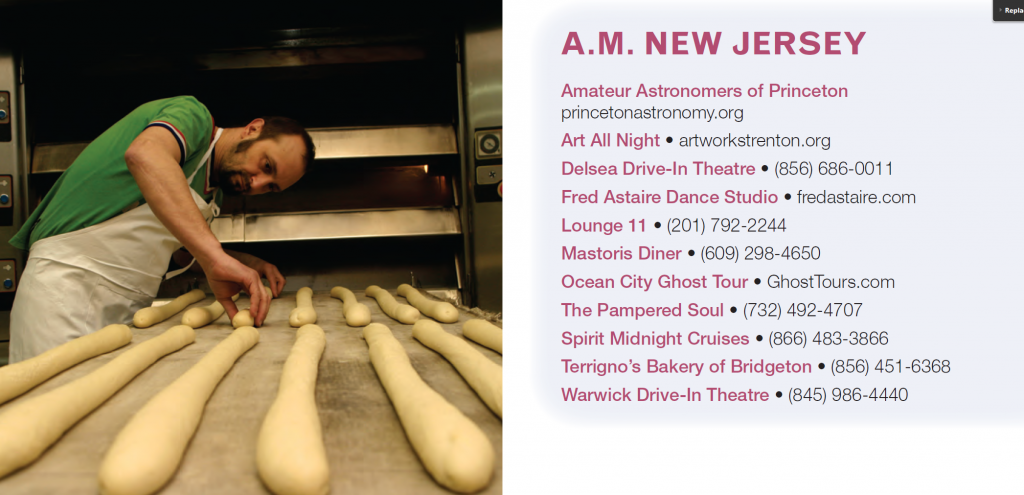
In the wee small hours, not all of New Jersey is in REM state I am an early bird. It has nothing to do with catching the proverbial worm; my day job in the financial sector simply required me to be up at the crack of dawn. No Late Night with Letterman. No Conan. No 1:00 a.m. road trips to the Wendy’s Drive-Thru. Whatever the rest of New Jersey was up to after midnight was of little interest to me. Then came the financial vortex of 2008–09, which inhaled my position and proceeded to transform me into an insomniac. I became the earliest of birds, a night owl. I soon found myself downloading songs on the Internet and dancing like no one was watching. Because no one was watching. It was time to get out and see what the rest of New Jersey was up to in the wee small hours. My first stop? That was easy. It was time to really learn how to dance.
CHEEK TO CHEEK Dancing in the dark is not just a Springsteen thing. The Fred Astaire Dance Studio—with six locations across the state— welcomed me with open arms when I requested an after midnight session. By appointment, these professionally run studios, manned by champion dancers, bowed to my presence. The first words I heard after all the midnight pleasantries were exchanged were: “Shall we?” The rest was a little slice of history. As I was leaving the studio another nocturnal soul came lilting in, ready to dance the rest of the night (or,  technically, the morning) away.
technically, the morning) away.
HOME INVASION Somewhere this evening in the Garden State, a group of ladies is enjoying a truly moving experience. They are spending the night in heaven courtesy of the Pampered Soul, whose magnificent, mobile spa rolls into your driveway to perform candlelight massages, facials, manicures, pedicures and other rejuvenating amenities.
’VETTE FLIX The good old days are still here if you’ve got a decent GPS. The Warwick Drive-In Theatre in Vernon and Delsea Drive- In Theatre in Vineland run movies past midnight and offer fully stocked concession stands. Hot buttered popcorn. A box of Junior Mints. Orange pop. Get the picture?
WINE FOR WATER I never really got over my long-ago infatuation with Love Boat. Perhaps that was what drew me to Lincoln Harbor, where Spirit Midnight Cruises shoves off at 12:30 a.m. and returns around 3:00. The journey begins with a dockside party and then it is smooth sailing on the Hudson in sophisticated style. Though true love eluded me on this particular voyage, the dancing, drinking, food and fun—not to mention the romantic views of the big city—beat the heck out of Circle Line.
NIGHTLY BREAD Whatever pundit wrote Man does not live by bread alone obviously hadn’t heard about Terrigno’s Bakery. The aroma of piping-hot loaves draws devotees down to Bridgeton right up to closing time, in the neighborhood of 12 o’clock. Think crusty on the outside, soft and doughy on the inside; seeded, whole grain, rye, sour dough, French, Italian. And for those who insist a balanced diet is a cookie in each hand, Terrigno’s also turns out a spectacular array of sweets, pastries, cakes, pies, and tarts. Bring an extra pair of hands.
LOUNGE ACT Frank Sinatra’s first group went by the name The Hoboken Four. Old Blue Eyes knew his way around the Mile Square City’s backstreets, bars and juke joints in the 30s, but even he might be overwhelmed by the after-midnight choices in the town today. Among Hoboken’s new and noteworthy hotspots is Lounge 11, at 505 Madison Street. An exclusive nightclub, bar and restaurant, it combines contemporary design with a hip New York atmosphere. The music selection is diverse, as is the crowd scene—especially on weekends.
SPIRIT OF DISCOVERY If you’re searching for weird in New Jersey in the pre-dawn hours, as a rule you shouldn’t have to look very far. If you’d prefer a more structured foray, then head to Ocean City, where eerie sounds and sightings highlight the candlelight strolls led by the Ghost Tours staff. No two tours are alike, says one guide, because “many strange and unusual things have been picked up on digital cameras. At times, even my own hair stands on its ends.”
STAR POWER Leave it to New Jersey’s own Ivy Leaguers to keep our eyes trained skyward all night. The Amateur Astronomers of Princeton have focused their know-how, curiosity and enthusiasm on princetonastronomy.org, an astronomy and cosmology web site that lets us know what to look for on those early a.m. strolls. A 24-hour phone line (609) 737-2575 suggests the best time to wish upon a falling star or view a cosmic display, and alerts callers to sudden developments in the night sky. A recent call described an unusual lunar citing visible at 3:00 a.m. Live updates are also available to Tweeters at princetonastro.
COUNTER CULTURE You knew this was coming, right? New Jersey is world renowned for its diners, and rightfully so. Entire books and web sites have been devoted to the subject. Golly, a whole page in this issue of EDGE has been devoted to diner culture! Rather than debate the relative merits of the Garden State’s classic eateries, I’ve chosen one to represent them all. The Mastoris Diner in Bordentown has been satisfying appetites and clogging arteries for more than four generations. An endless menu only hints at the jaw-dropping portions that cascade out of the Mastoris kitchen—which often serves 2,500 customers a day. Technically this is not an all-night diner; the Mastoris staff catches its breath for a couple of hours after 1:00 a.m. every morning. But that has not kept it from becoming one of Jersey’s most cherished late-night traditions.
Marilyn Monroe is said to have had $3.50 in her apartment when she died. Yet she will make more money this year than all but a handful of Hollywood stars. How is she worth more dead than alive? Who gets that money? Who doesn’t (but should)? Welcome to The Marilyn Wars.
Marilyn Monroe has been dead for 48 years. Do you care? In some years the dead Marilyn earned over $7 million on sales of over $60 million in merchandise bearing her name or image. Still don’t care? Well, I know who does care. A unique group of sharp business people, creative lawyers, nostalgic purveyors of porn, scheming collectors, paranoid political conspiracy theorists, fraudsters and infringers, fans and obsessed idolaters, and loyal devotees who seek to prolong their candle in the wind. These are the soldiers in The Marilyn Wars. They are engaged in a struggle of constant calumny, lawsuits, claims of fraud and theft, and even threats of duct-and abduction.
The main battlegrounds are the federal courts and state legislatures, and the principal combatants are the estates of various artists claiming conflicting intellectual property rights in Marilyn, and the publishers and photographers who took the iconic photographs reproduced on so many of the pieces of merchandise sold under her name. The rest of the colorful players (who are worthy of their own article) are cheerleaders of varying stripes. Over the last few years, The Marilyn Wars changed the entire playing field for intellectual property rights known as “rights to publicity,” sparking precedent-setting court cases from coast to coast who owns a piece of what or whom.
And all over symbol who would have recently turned 83. A product of national obsession and hard work behind the scenes, Marilyn’s estate—in tandem with its licensing agents and others—has fought to ensure that her memory lives on, and productively so. Marilyn’s name or image has appeared on dozens of products and advertisements, from a “Marilyn” perfume line in Europe to advertising campaigns with Dom Perignon, Absolut and General Motors. There are even Marilyn-themed casino slot machines and a line of pet clothing that includes a hot-pink dog dress with the slogan, “Diamonds are a Dog’s Best Friend.” (Seriously.) Would you reach for a bottle of water bearing the iconic image of Marilyn stretched out on a red velvet blanket over one of Fuji or Evian? Gauging from their labels, the makers of Star H2O must think so. So who owns Marilyn, and who or what has the right to the proceeds from her legacy? After all, that’s what The Marilyn Wars are really all about.
In her will, Marilyn left the residual of her estate to her acting teacher, Lee Strasberg of New York. Some years after Marilyn died, Strasberg married named Anna Mizrahi, who by many accounts never met Monroe. After Lee died, Anna connected with Mark Roelser, who had founded a company now called CMG Worldwide, headquartered in Indianapolis. This location is important because Roesler had lobbied the Indiana legislature to pass a law giving rights to publicity to the estates of deceased people— despite the fact that they were already dead when the law was passed, thus coining the term, “posthumous rights to publicity.” This allowed CMG to capitalize on the rights of publicity licensed to his company by the heirs of deceased celebrities. CMG began enforcing these rights around the country, encouraging those selling merchandise using those names to pay a licensing fee for the privilege. Over time, this became big business.
Today CMG represents scores of “living legends” ranging from Monroe to Malcolm X. Some American icons became, in effect, worth more dead than alive. Who in 1947—the year when Marilyn was crowned Miss California Artichoke Queen—would have guessed that over $30 million would have been collected on Marilyn merchandise and advertising through the end of last year? Among those requested to pay fees for the use of Monroe’s image have been the heirs to photographers who themselves had taken some of the iconic photographs of Marilyn that the estate was exploiting. One such instance involves the famous publicity still from the film The Seven Year Itch where Marilyn is standing above a New York City subway grate with her dress billowing up around her. Issues of copyright and right to publicity are now center stage as CMG and other combatants in The Marilyn Wars have staked competing claims over who or what has the right to capitalize on Marilyn’s robust brand.
While the CMG-friendly courts of Indiana have enforced posthumous rights to publicity, the courts and statutes of other states such as New York and California have not necessarily followed suit. Importantly, New York has no laws granting posthumous rights of publicity. California, another state in which Marilyn maintained a home, did have such a law passed, but only in 1984, some 22 years after Monroe’s death. However questions were raised about its retroactive effect. In 2007, a court ruled that because there was no such right in New York (and that California’s law had no retroactive effect), no such right existed when Marilyn died in 1962 and, therefore, it was impossible for her to have conveyed that right in her will. You can’t convey something that you don ’t own, and if it didn’t exist when you died, you can’t have owned it. While these litigations and appeals are ongoing, CMG continues to own numerous registered trademarks relating to Marilyn Monroe. But others are jumping on the Marilyn bandwagon, such as her photographers and others claiming interests in her image.
The Marilyn Wars, in other words, are just heating up (and one can only imagine the fires soon to rage regarding the Estate of Michael Jackson). Their outcome impacts hundreds of millions of dollars and has implications to the estates of scores of famous people and their future estates. It will take some years before the stardust settles, but in the meantime, Marilyn keeps smiling and profiting a great many well beyond her few happy years. Not bad for a “candle in the wind.”
Editor’s Note: Neil Patrick Parent is a partner in the Manhattan-based law firm Reavis Parent Lehrer LLP (www.rpl-law.com ) with affiliates in Los Angeles and San Francisco. The firm has a practice group concentrating in intellectual property and entertainment law. This article is not intended to convey legal advice and individuals seeking information concerning the above should seek appropriate legal counsel.
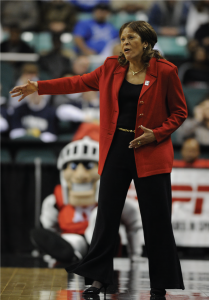
Grant Halverson/Rutgers University
If you had to win one game and could take any coach in the state, Vivian Stringer would unquestionably be among your top candidates. If you could select a coach to guide your daughter through the most important four years of her life, the Rutgers basketball legend would be a no-brainer. Coach Stringer has graced the Garden State with her presence since 1995, and during that time she has elevated the state of the game, both on and off the court. A three time Coach of the Year, she is one of only three people in women’s hoops history to win 800 games.
As it happens, EDGE Assignments Editor ZACK BURGESS has some history with his interview subject—they first crossed paths 10 years ago when he covered her Rutgers team for The New York Times. He knows as well as anyone that her triumphs have not come without their share of tragedy. She has persevered through the deaths of her father and husband, a daughter devastated by meningitis, and a son who nearly lost his life in a car crash. Some people define “grace” as the bestowing of God’s blessing. Zack pulled Vivian Stringer off the court to talk about this idea, as well as the dual challenges of being a coach and mother. And yes, he managed to sneak in an Imus question!
EDGE: Given the dramatic ups and downs and challenges in your life and career, do you feel blessed?
VS: Yes, I do. I wake up every day and witness other people’s plights, and just shake my head and wonder, ‘How do you handle it all?’ You just have to understand that when there is life, there is hope. Blessed? Yes.
EDGE: What does it mean to you to go into the Basketball Hall of Fame with Michael Jordan this year?
VS: I really haven’t allowed myself to think about it. I probably would be paralyzed if I thought about it too much. To go in with arguably the greatest class the Hall of Fame has ever seen is an honor. I have to prepare myself for the greatest day in my life, besides the birth of my children. It’s overwhelming. When I started at Cheyney State (in Philadelphia), I never believed that I would find myself receiving such a huge honor.
EDGE: How soon after you got the coaching job at Cheyney State did you know this was your calling?
VS: Are you kidding me? The minute I got there! I was just grateful they gave me a chance to coach the team. It was magical. I was 22 years old and loving every minute of it. It’s what I was meant to do.
EDGE: How do feel you did raising a family and being a college basketball coach?
VS: I did a masterful job as a parent of keeping basketball and my family separate. But now I wish I wouldn’t have kept things so separate. Those trips through the Midwest were tough. We were going from Iowa to Wisconsin. Instead of being on the team bus, I wish I had ridden right behind the bus for those six or seven hours, giving my kids more mommy time. Listening to them say mommy this, and mommy that. I was fortunate enough to have the best husband in the world.
EDGE: Where did being a coach and being a mom intersect?
VS: My son David played Division-I football. So not only do I know what it’s like to go into a home and recruit, I know what it’s like to be on the other end of the recruiting process as a parent. I know during his recruitment process I often looked for who was going to care about my son—who was going to push him to be the best that he can be, who was going to understand how special he is as a person. Ultimately, that’s what every parent wants. They want to know that their child is going to be safe and understood. I try to be the coach I would want for someone to be to my child. I want parents to understand that I am a parent, too. Parents have a right to see their child walk through your program okay, and emerge a better person at the end.
EDGE: Yet you have a reputation for being tough on your players. Is that fair?
VS: They say that I don’t get players sometime because I am known for being hard. What makes what I do any different from anyone else? Players who go to the University of Tennessee know they are going to a place where they just flat-out had better get it done. What I am trying to teach my players is to be good women. I want them to understand that when they come to Rutgers, they are not only here to play basketball, but to become young women who know how to empower themselves as well.
EDGE: Someone once told me talent and hard work always wins out. Do you believe that?
VS: I think perseverance, talent and hard work is what we should say. Thirty-eight years of doing this. I would like to think when my story is told that it’s one of perseverance, because you can have all the talent in the world—and you might even have a good work ethic—but without perseverance, none of it matters.
EDGE: What are the qualities you look for when you are recruiting a player?
VS: She has to have the will and the drive to be the best, and the skill to play the game. Someone who is not satisfied unless she is as good as she can possibly be, which means she is probably never satisfied. The more difficult something becomes, the more she sees it as an opportunity versus an obstacle. These qualities will carry her throughout the rest of her life.
EDGE: Have you ever gone against your rule and taken a player who had the skill but maybe not the drive?
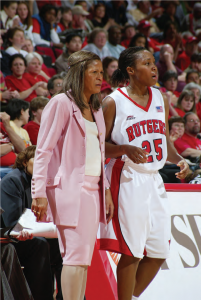
Larry Levanti/Rutgers University
VS: Sure I have. It doesn’t work.
EDGE: Getting back to the idea of grace, I have a final question. Lost in the uproar after Don Imus made those infamous remarks about your players was the fact that you were quite gracious in accepting his apology. Why was that important to you?
VS: I think we found ourselves in a situation where we needed to forgive. My faith wouldn’t have me do it any other way and I knew that. When Imus said what he said, it hit me to the bone. I’ve never been one to be able to smile and say it’s over—I really need to do a much better job—so in order for us to go forward, we just needed to forgive.
EDGE: How many of those girls are still on the team?
VS: We have four kids left from that class who are now going to be seniors.
EDGE: And how are they doing?
VS: One is going to be doctor, one a pharmacist, one wants to be lawyer and another who can do whatever she wants. To see what these young ladies went through and have them come through it with their dignity and honor intact is a wonderful thing. I’m very proud of them.





The Schnitzspahn Collection
Jack Nicholson. Bruce Springsteen. Tom Cruise. Queen Latifah. Our state’s contributions to the entertainment industry have been endlessly chronicled and commemorated. Yet generations before New Jersey became a “supplier” to the performing arts, it actually served as the epicenter of the entertainment world. Indeed, between the Civil War and World War I, summertime was showtime in the Garden State. For when New York City’s wealthy theatre-and-concert-goers headed across the Hudson and turned south, the 19th century’s American Idols followed. The show must go on, so they say, and it did—in playhouses and small-town theatres up and down the Jersey Shore. Historian Karen L. Schnitzspahn chronicled this annual exodus in her book Stars of the New Jersey Shore, and kindly agreed to give EDGE readers a rare peek at her priceless collection.
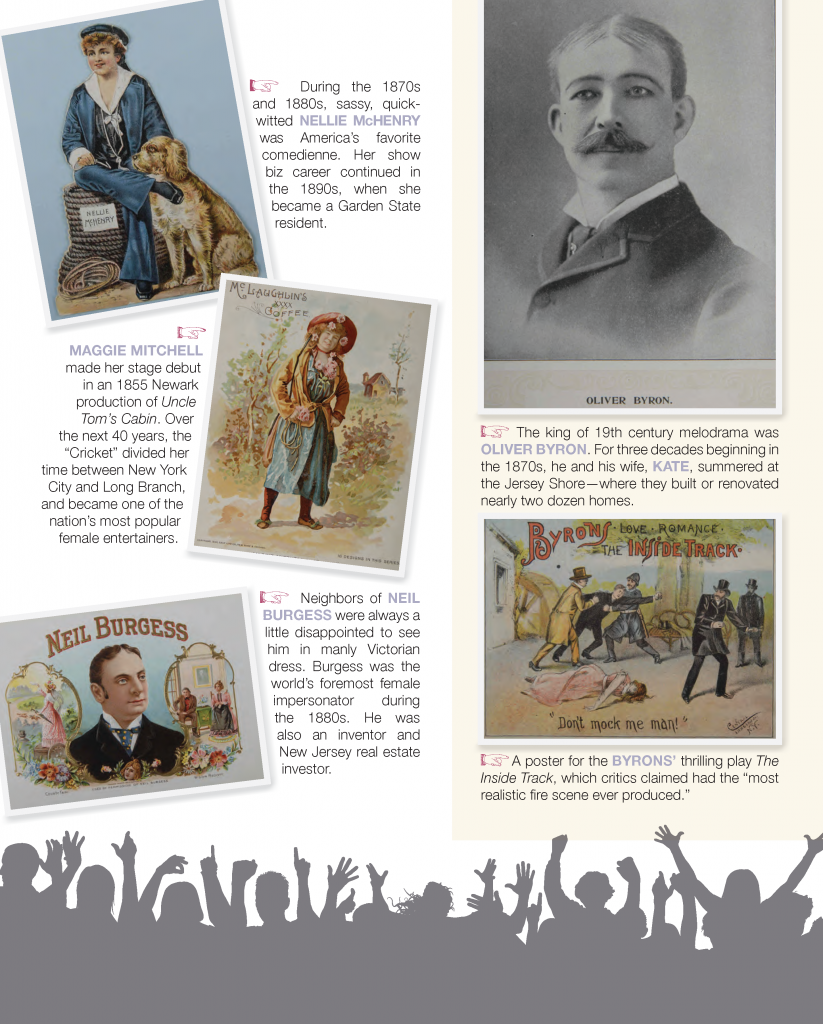

Shiny hair and teeth, longer legs, firmer abs, cooler apartments, faster cars—the list of differences between TV docs and the real-life ones is practically endless. Yet from a practical standpoint, the difference that matters the most to real-life patients is this: Can you help me? That’s when the TV docs disappear and the true problem-solvers hit their mark.
Let’s face it. Who doesn’t love a good medical drama? When some “Doc Hollywood” sinks his teeth into a perplexing patient, we are transfixed. These television characters will crack the case—we know it and, on some level, we know they know it, too. The medical dramas that play out on hospital floors every day present the same challenges and demand the same out-of-the-box thinking. However, when a patient stares desperately into a doctor’s eyes, that’s not acting. It’s the real deal. We asked a trio of the top docs at Trinitas to “state their case”—the one that intrigued or challenged them, surprised or gratified them, the kind that makes real-life doctoring far better than doctoring As Seen On TV.
A HELPING HAND For Dr. Richard Mackessy, the chairman of Trinitas’ orthopedics department and a specialist in hand surgery, the toughest patients are often the youngest. He’s spent the past 20 years donating his surgical expertise to Healing the Children, a nonprofit that helps children from around the world come to the U.S. to receive treatment. “Most of the kids have congenital problems with their legs that keep them from getting around,” he says. “We usually have to amputate and give them a prosthesis, but the results are amazing—it allows them to be up and walking around, independent and functional.” Healing the Children sponsored two of Dr. Mackessy’s most memorable patients—a pair of children from Russian orphanages who had severe hand deformities. The first, a boy, was missing a thumb due to a congenital condition. Dr. Mackessy was able to utilize the index finger to create a thumb for the little boy. “You situate the index finger in a different way, attach different muscles, and take one of the bones out of it, and you’ve created a thumb.” The surgery helped the child gain use of his hand. Another, a little girl, was missing most of her left arm below the elbow, and the fingers on the right hand were fused together. Dr. Mackessy was able to separate the thumb and fingers on the right hand, and perform surgery to make her left arm more useable. Both kids not only regained the use of their hands, they gained something else—while they were in America for their surgeries, they were adopted by U.S. families. Dr. Mackessy says he constantly sees the power of medicine. “[This work] makes you see life differently—it shows you what medicine can do for people.”
THE HEART OF THE MATTER For Dr. Arthur Millman, head of Trinitas’ cardiology center, mending broken hearts is all in a day’s work. One of his most interesting patients was a 70-something lady who wanted to skydive. “She wanted to get a letter from us that said that she could go, but she was in severe heart failure, with a leak in the mitral valve,” he recalls. After she was stabilized, Dr. Millman was able to surgically repair her valve. “While you can replace the valve, doing so damages the heart muscle and creates illness in the patient,” he says. “If you are able to fix the valve instead, it’s still you, not some piece of plastic or something that came from a cow or a pig.” With this valve repair, he was able to give the patient a whole new lease on life. “She can take care of herself now, go shopping—things she couldn’t do beforehand. I still tell her that skydiving isn’t a good idea, though.”
SOLVING A MEDICAL MYSTERY When a young diabetic patient came to Dr. Paul Vaiana early in his medical career complaining of numbness in his hands and feet, the now-president of Trinitas Regional Medical Center’s Medical and Dental Staff, might have assumed that the problem stemmed from a failure to take his medications. But Dr. Vaiana noticed something that concerned him. “He had no motor strength, and that made me think that something else was happening.” A spinal tap revealed the cause—Guillain-Barré syndrome, a disorder in which the nervous system comes under attack by the body’s immune system. At the time, not much was understood about the disease, but Dr. Vaiana knew his patient was running out of time. “I knew it needed to be addressed quickly with a very specialized treatment,” he recalls. “If you aren’t able to wash the patient’s blood, they became ventilator-dependent quickly.” Dr. Vaiana and the hospital were able to locate a plasmapheresis machine within 24 hours to cleanse the patient’s blood and get him on the road to recovery. “Everyone worked together on this young man and in three days he was out of the woods,” he remembers. “We were so aggressive in treating it, and now that is the standard care of this disease.” Three decades later, that young man is still Dr. Vaiana’s patient. “I love practicing medicine and having a relationship with my patients,” Dr. Vaiana says. “It’s not the money driving care here—I’m glad to be part of a team who really goes out of their way to help people in their time of need.”
Editor’s Note: Lisa Milbrand is a New Jersey-based writer whose articles on health and relationships appear in Parents, Arthritis Today and Modern Bride. Her blog themamahood.com celebrates the life of a working mother.
Clean living. Prudent diet. Sunscreen savvy. All vital to healthy skin. And all easier said than done.
People spend billions of dollars a year on products that promise to make their skin firmer, fresher and younger. But doctors who focus on caring for the skin insist that the body’s largest organ needs more than over-the-counter potions to maintain its health and radiance—and to do what it was designed to do. “Skin is the protector of our body and the first line of defense,” says Dr. Kamran Khazaei, head of Nouvelle Confidence, the Center for Cosmetic Laser & Rejuvenation. “The first thing that’s affected when you come in contact with pollutants, bacteria and other toxins is the skin—that’s why you have to continually do maintenance on the skin, to allow it to work its best.” Everything we eat, breathe, and do affects our skin, and the results aren’t always pretty—especially when people neglect the basics of skin health.
Here’s how to ensure you protect the skin that protects you. SKIN RAVAGERS While genetics can play a role in how easily you burn or scar, whether you freckle and how soon you show signs of aging, experts say that lifestyle choices have the biggest impact on your skin’s health. Smoking, eating an unhealthy diet, exposure to pollutants and even a lack of sleep and exercise can cause premature aging and other skin problems. “Smoking and a poor diet absolutely damage the skin,” says Dr. Khazaei. “Any type of toxin in the body affects the whole body, including the skin.” But when it comes down to it, sun exposure continues to have the most punishing effects on a person’s skin. “The worst enemy of the skin is the sun,” says Dr. Khazaei. “Everyone thinks they look healthier by tanning themselves under the sun, but that’s the worst thing to do for skin health.” It’s hard to avoid news reports on the dangers of sun exposure, but surprisingly it hasn’t had a huge effect on people’s behavior.
Recent CDC studies have shown that 40 percent of adults don’t use sunscreen, and 70 percent of those who use sunscreen don’t bother to reapply when it’s recommended. It’s the ultraviolet radiation that causes most of the trouble—particularly UVA rays. “UV radiation is a known carcinogen, and is associated with both an increased risk of skin cancer and an increase in skin aging,” says Dr. Joseph Alkon, a plastic and reconstructive surgeon at Trinitas Regional Medical Center, who specializes in treating skin cancers. Unfortunately, many people have taken their desire for darker skin straight to a more dangerous spot—the tanning bed—where UVA rays are three times more potent than in natural sunlight. “There has been a rise in the number of people using tanning salons, including teens and younger patients,” says Dr. Alkon. “More than one million people use tanning salons on a typical day in this country—70 percent of whom are females in their late teens to late 20s.” Tanning bed use, he adds, may put you at even more risk of cancer and other damage.
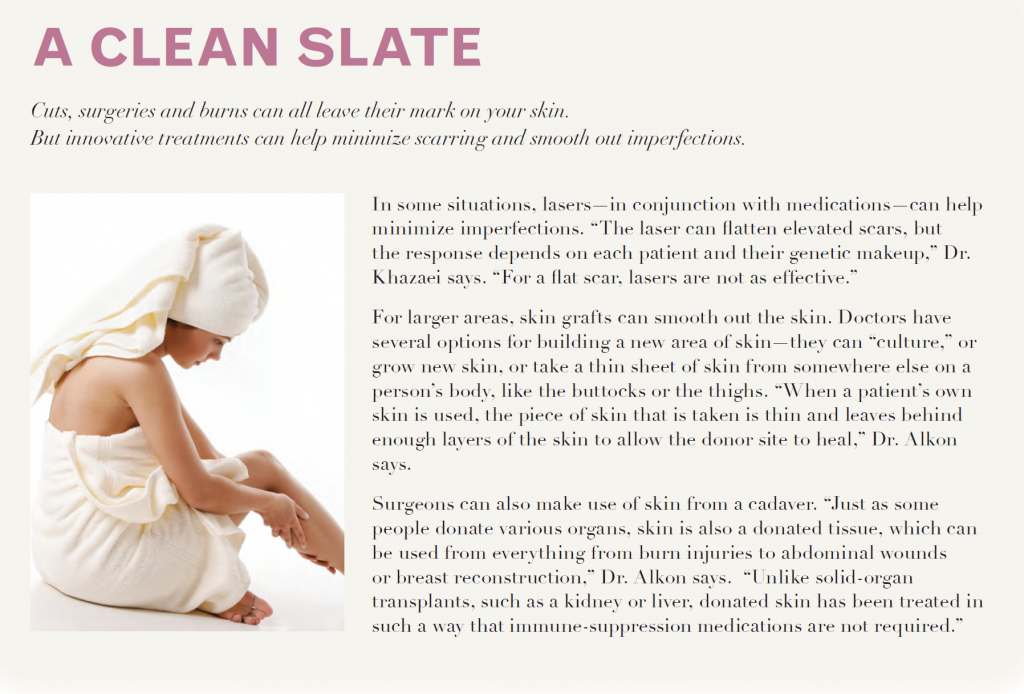
SAVING YOUR HIDE You may think you’re a lost cause after decades of sunscreen-free sunning at the shore, but there’s still plenty to be done to improve the health—and look—of your skin. Dr. Khazaei uses laser and microdermabrasion treatments to help combat the signs of skin damage. “Laser treatments help regenerate collagen formation to rejuvenate the skin, and can be used to treat freckles and age spots,” he says. “Microdermabrasion removes dead skin cells that are produced by the sun, exposing the younger, healthier skin beneath.” Customized skin care products—like Dr. Khazaei’s own line—can help clear away dead cells and revitalize the skin beneath. But the best protection is prevention—and that means stopping smoking, getting more sleep, eating better, and most importantly, using sunscreen regularly. “Even on a cloudy day, you need sunblock to protect the skin—the rays that cause the most damage can still pass through the clouds,” Dr. Khazaei warns. “If you take care of your skin, it naturally stays younger and lasts longer.”
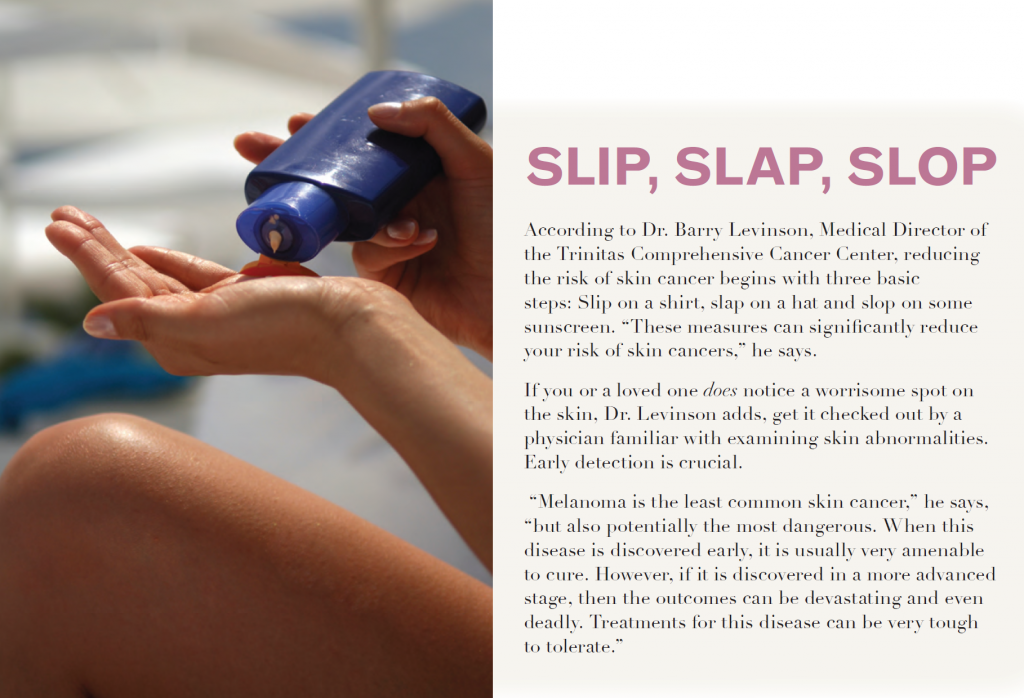
Editor’s Note: Lisa Milbrand is a New Jersey-based writer whose articles on health and relationships appear in Parents, Arthritis Today and Modern Bride. Her blog themamahood. com celebrates the life of a working mother.
As 20th Anniversaries go, Sarah Chang’s is one of the more remarkable. She has been captivating audience since age 8, mastering some of the most challenging violin concertos with awe-inspiring passion and precision when her peers were still proud of how well they tied their shoes. Now 28, Chang’s résumé is pages long when others her age are just getting their career-defining breaks. She has enchanted audiences from Carnegie Hall to the Kennedy Center to the great concert halls of Europe and Asia. She has shared the stage with fellow luminaries from Pinchas Zukerman to Yo-Yo Ma. Chang’s CDs are best-sellers. She has even carried the Olympic torch. EDGE sent ZACK BURGESS on assignment to profile Sarah Chang. His job was to peel away the layers that typically accompany international stardom and acclaim, and get to the heart of this transplanted Jersey Girl. Sarah made it easy. Her poised and stunning facade notwithstanding, she is still a kid at heart.
EDGE: Every parent of a talented daughter dreams that their child will have the life that you do. So let’s get the obvious question out of the way. Do you ever yearn to be someone other than yourself, to slip out of your skin and into someone else’s?
SC: Maybe for a day, but not any longer than that. I love my life. I have been traveling all over the world since I was a 10-year-old. I’m 28 and have seen and done things that are just unimaginable.
EDGE: When did you request your first violin?
SC: At four. My father played the violin and I wanted to be like him—I’m a daddy’s girl, like most little girls. I was playing the piano at the time and thought it would be great to play something else. Besides, I wanted something to carry around.
EDGE: At what point did you realize that your life was going to be different?
SC: I performed with the New York Symphony Orchestra when I was only eight. I knew there was something that wasn’t normal about that. But I didn’t think I had a “gift.”
EDGE: As an adult, have you ever experienced the fearlessness you did back then?
SC: No. I was a kid. I just did it! I didn’t think about it. Of course, now, I’ve been doing it forever and this is my life, but back then I just went with it, like most kids do.
EDGE: What was it like working with older musicians?
SC: Everyone would be going to parties after a performance and here I had to go back to my room or go study. It was frustrating then but, hey, I was a kid, a teenager. Nothing is fair when you’re that age.
EDGE: So today, as a 28-year-old, what is the downside of being Sarah Chang?
SC: The travel. Sometimes I wake up and don’t know where I am, or what city I’m in. But then I remind myself of what I do, and how I get to entertain people all over the world— and that, at an age when others are just breaking into this business, I have been doing this for twenty years now. I’m already booked out to 2012, which is a great “problem” to have when you’re an artist.
EDGE: What’s your greatest obstacle as an artist?
SC: Having to be good every night, even on those days when I don’t feel well. It’s what the public expects from me and, realistically, it’s what I expect from myself.
EDGE: Which can get rather difficult.
SC: Because I’m human.
EDGE: Does it all seem surreal sometimes?
SC: Sometimes. But for the most part I’m used to it. I don’t go through this wow syndrome, where I have to pinch myself. I’ve been doing it for so long. I’m a professional. You know what I mean?
EDGE: How does dating work when you’re Sarah Chang?
 SC: It’s a challenge as a young woman on tour. It’s really hard to have a personal life when one person is in one place and the other is somewhere else. I would like to settle down someday, but I would also like to be a committed mother and wife when that happens.
SC: It’s a challenge as a young woman on tour. It’s really hard to have a personal life when one person is in one place and the other is somewhere else. I would like to settle down someday, but I would also like to be a committed mother and wife when that happens.
EDGE: When were you finally on your own?
SC: My parents stopped traveling with me when I was around 18 or 19—which presented a challenge because they were no longer there to protect me. I made my fair share of mistakes. But I’m having fun at this point in my life.
EDGE: What was life like before that, as a 13- or 14-yearold?
SC: I was just like any other teenager who thought the world owed me something. In retrospect it was no big deal. You know, here I am performing one minute and doing homework by fax for Germantown Friends and Juilliard the next. I was always struck by how much younger I was than everyone else, and that bothered me. I missed a lot of parties. But now that I’m older, in retrospect it really was no big deal.
EDGE: What do you do on days when you’re not performing?
SC: I’m just like everybody else. I’m human. I have everyday highs and lows just like everyone else. I would say I just like to have a day to myself. No cell phones, no Blackberrys, no emails. But that rarely happens. I probably wouldn’t know what to do if it did.
EDGE: Is there anything you miss about being a Jersey Girl?
SC: Of course. I miss the driving—and the space. I’m a terrible driver, so I could really use the space!
Photos courtesy of Sheila Rock/Opus 3 Artists
While the skincare industry touts its latest, greatest miracle-working scientific formulations, actual science increasingly links healthy skin to what you put IN your body, not ON it.
Skin is the largest organ of the body. It’s the only one that is instantly visible. And it is vulnerable to all sorts of attacks, including dryness, excess oil, wrinkles, sunburn, acne, dermatitis, rosacea, eczema, psoriasis, seborrhea, and various forms of cancer. Millions of consumers shell out billions of dollars on topical skincare products each year in an effort to improve the look and feel of their skin. All the while, they may be missing a more obvious, cheaper, and better way to reach their goal. Food.
In their book Beauty Basics for Teens, Dianne York-Goldman and Mitchel P. Goldman, M.D., urge a balanced diet that includes carbohydrates, protein, nutrients and fiber, but is low in saturated fats and empty calories. They also advise drinking at least eight 8-ounce glasses of water each day for proper hydration. The goal is to eat foods rich in vitamins, minerals, antioxidants, and healthy fats. Melody L. Meyer of Albert’s Organics, a California-based natural products distributor, suggests leafy green vegetables for iron and calcium, sweet juicy fruits (especially at breakfast), a variety of whole grains, and easy-to-digest proteins like legume soups, paneer (cheese made from boiling milk, adding lemon and straining solids), and lassi (diluted yogurt and spice drinks).
Carotenoids, which are found in red and orange fruits as well as in yellow and dark green vegetables, are recommended by Sharrann Simmons of Cognis Nutrition & Health, an Illinois-based food technology company. She says that carotenoid lutein has been shown to protect skin against UV-damage, improve skin hydration, encourage elasticity and enhance beneficial lipid levels. For its “Beauty from Within” campaign, DSM Functional Food Marketing of New Jersey also enlists carotenoids, as well as antioxidant vitamins C and E, green tea extracts, omega-3 fatty acids (which can be found in fish and flaxseed), and polyphenols (derived from olives). Consumers seem to be getting the message. A recent study by the Mintel Group, a market research fi rm, notes that 2008 saw the debut of more than twice as many new beauty foods and beverage products as there were in 2007.
Dermatologist and author Nicholas Perricone urges a diet loaded with these essential proteins: fish, poultry and, occasionally, lean beef, pork or ham. He also suggests consumption of soy foods like tofu and tempeh, egg whites, low-fat cottage cheese, low-fat milk, and yogurt. For carbs, he favors squash, spinach, onions, green beans, asparagus, cabbage, cauliflower, eggplant, collard greens, escarole, green peppers, strawberries, raspberries, apples, blackberries, blueberries, cantaloupe, honeydew, and kiwi. Recommended fats include oils derived from olives, walnuts, safflower, soybeans, rapeseed (canola), and sunflowers, as well as nut butters and avocado.
Perricone also is high on the following ten “Superfoods”: Aτai (pronounced ah-sigh-ee), a high-energy berry that grows in the Amazon The allium family of foods, including garlic, onions, leeks, scallions, shallots, and chives, all of which are rich in flavonoids. Barley, which is not only low on the Glycemic Index, but high in both soluble and insoluble fiber. Green foods, which are derived from cereal grasses and blue-green algae. Buckwheat, also low on the glycemic scale, and which may be substituted for less healthful grains like rice, wheat, and corn. Beans and lentils, an alternative to fattier meat proteins. Hot peppers, which are high in heart-healthy, anti-inflammatory compounds. Nuts and seeds, which are a source of good fats. Sprouts for their enzyme content.
Yogurt and kefir, fermented dairy products that add digestion-aiding probiotics to the diet. J.T. Ryan is a licensed physical therapist and owner of Healing Touch in Howell. The company makes and markets handmade natural body-care products. She emphasizes the need for trace minerals and electrolytes, which she calls “a key to cellular regeneration.” For example, Ryan says, a deficiency in copper will lead to scar formation during the skin’s 40-day cycle period. Foods rich in copper include most nuts (especially Brazils and cashews), seeds (especially poppy and sunflower), chickpeas, liver and oysters. Are there foods that should be shunned if your goal is shiny, smooth skin? Most definitely. This is particularly true if you are worried about acne. Naturopath Alan C. Logan, who teamed with dermatologist Valori Treloar on the 2007 book The Clear Skin Diet, cautions against the foods most popular with American teenagers—pizza, hamburgers, cookies, crackers, fried potatoes, salty snacks and sweetened beverages.
Even milk consumption is “strongly associated with acne,” the authors claim. In place of these no-no’s, Logan argues for a diet that focuses on the omega-3 fatty acid eicosapentaenoic acid (EPA), found in fish like mackerel, sardines and salmon, tomato extract with the carotenoid lycopene, marine fish that are rich in collagen, and a high-flavanol cocoa extract. Logan explains that inflammation is at the core of acne, and that oxidative stress, a byproduct of the standard American diet, “fans the flames of inflammation.” Fish oil, he says, especially EPA, blocks the production of the inflammatory chemicals. This also is why antioxidant fruits and vegetables are so important. Does this mean you have to toss away all your lotions, creams and ointments? Of course not. They definitely serve a purpose. But keep in mind that if you really want a smooth, healthy complexion, a good nutritional foundation is where you should start.
Editor’s Note: New Jersey-based freelance writer Alan Richman is the former editor of Whole Foods Magazine.




